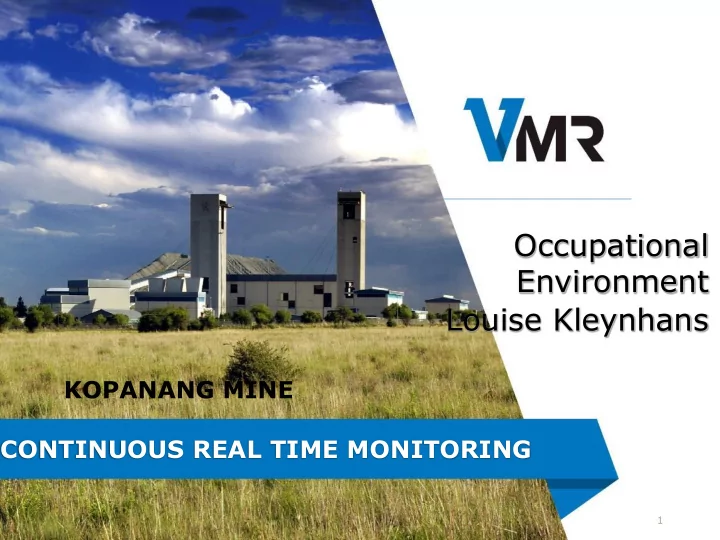

Occupational Environment Louise Kleynhans KOPANANG MINE CONTINUOUS REAL TIME MONITORING 1
2 Contents Background Description of practice Effectiveness of engineering controls Schematic layout The monitor Project phases The problem area Results before and after Pre- and post strategy Benefits/Advantages Key lessons learnt Introduction of Dust Task Team Vision
3 Background • In 2011 Kopanang Gold Mine was selected as the SOURCE MINE for Continuous Real time Monitoring of Airborne Pollutant Engineering Controls • The project was a huge success and documented as the “MOSH Leading Practice that will make a difference” • Kopanang Mine is still using this practice daily to monitor the effectiveness our of Engineering Controls
4 Description of practice Baseline • Following an identification process on the shaft, continuous monitors were placed on the intake air and direct return air side of an engineering control. Monitor • The ambient air condition is then monitored continuously in real-time and transmitted to a surface control room. Alarm •Should a “dust alarm” occur the control room operator will initiate a call out procedure to investigate the alarm. Action • Following investigation, an action log will be put in place to rectify the condition thereby preventing people to be over- exposed to harmful dust concentrations.
5 Engineering controls - effectiveness Efficiency The efficiency of engineering controls are normally dependant on the human factor The strategy indicated a need to: - test the effectiveness of the engineering controls - determine whether current engineering controls are effective Other needs identified A need was identified for continuous dust monitoring to get an overview on exposure of dust on employees working underground Installation of instruments 14 Instruments were installed in a ventilation district underground
6 Schematic layout (phase 1) Bank Up-cast Downcast KOP1 Ventilation District Shaft Shaft 6A x/cut 9 x/cut 44 Level Stn Tips 9 x/cut 47 Level Stn Tips 50 Level 18 x/cut Stn Tips • Installations were done in the following areas: Surface, the downcast shaft Before and after various tipping areas Haulages and at the entrance to a development end. • This was done to measure the effectiveness of current engineering systems installed underground.
7 The real-time monitor AMS THERMO PDR1100 DUST LEVEL TRANSMITTER
8 Project phases Phase 1 • Sensors installed in Kopanang Upper Mine • Trends analysed from the real time sampling instruments proofed that engineering controls in that ventilation district is sufficient for the dust load Phase 2 • Workers on 59 level complained about excessive dust during tipping operations • With engineering controls installed, the dust problem persisted . • Monitors were moved to 59 Level to assist with identifying the cause and source of the dust problems. • Immediately after installation the trends indicated that although high dust readings were obtained during tipping, the main cause of dust was during the transfer between levels . • It was decided that the transfer time should be moved to late afternoon, after the shift, thus reducing the employees exposure to dust • All engineering controls were automated • With the above process complete, the dust problem is effectively managed
9 59-Level station diagram Tips Tips Tips 59 Level
10 Sensor results - Before
11 Sensor results - After
12 Pre-strategy Problem finding vs monitoring 20% Trouble shooting Dust Management 80%
13 Post-strategy Problem finding vs monitoring 20% Dust Management Trouble shooting 80%
14 Benefits/Advantages Fast reaction time possible Manage effectiveness Move away from of engineering control reactive management installed underground mode into a proactive approach Real-time Monitoring Can monitor the No consumables whole mine and low simultaneously and maintenance continuously You get the real picture of happenings underground in real time
15 Lessons learnt • Buy-in from multiple departments and stakeholders needed for this program to succeed. (Ventilation, 1 Engineering, Mining etc) • Proper training required ( Installation, operation and maintenance of instruments) 2 • Awareness campaign a necessity 3 • Spare instruments should be available 4 • The System will only work if it is properly and timeously maintained 5 • Establishing the Kopanang Dust task team, proved to be very beneficial to the success of this practise 6
16 We are committed to make a D I F F E R E N C E Success story W Blaai V Lengisi E Semoeng Previous V Msi Dust Task Team T Bulwa
17 We are committed to make a D I F F E R E N C E K Merahe Success story G Tladi E Semoeng Dust S Sanqu Task S Makanda Team Z Malingo
18 Our vision 1 • To monitor the whole mine simultaneously and continuously 2 • Continuous improvement towards zero harm from silica dust and other airborne pollutants • Improved identification of problem 3 areas – by getting the real picture in real time on activities as it is happening underground
19 Closure With Real-time Monitoring these days are gone FOREVER !!! Thank You
Recommend
More recommend